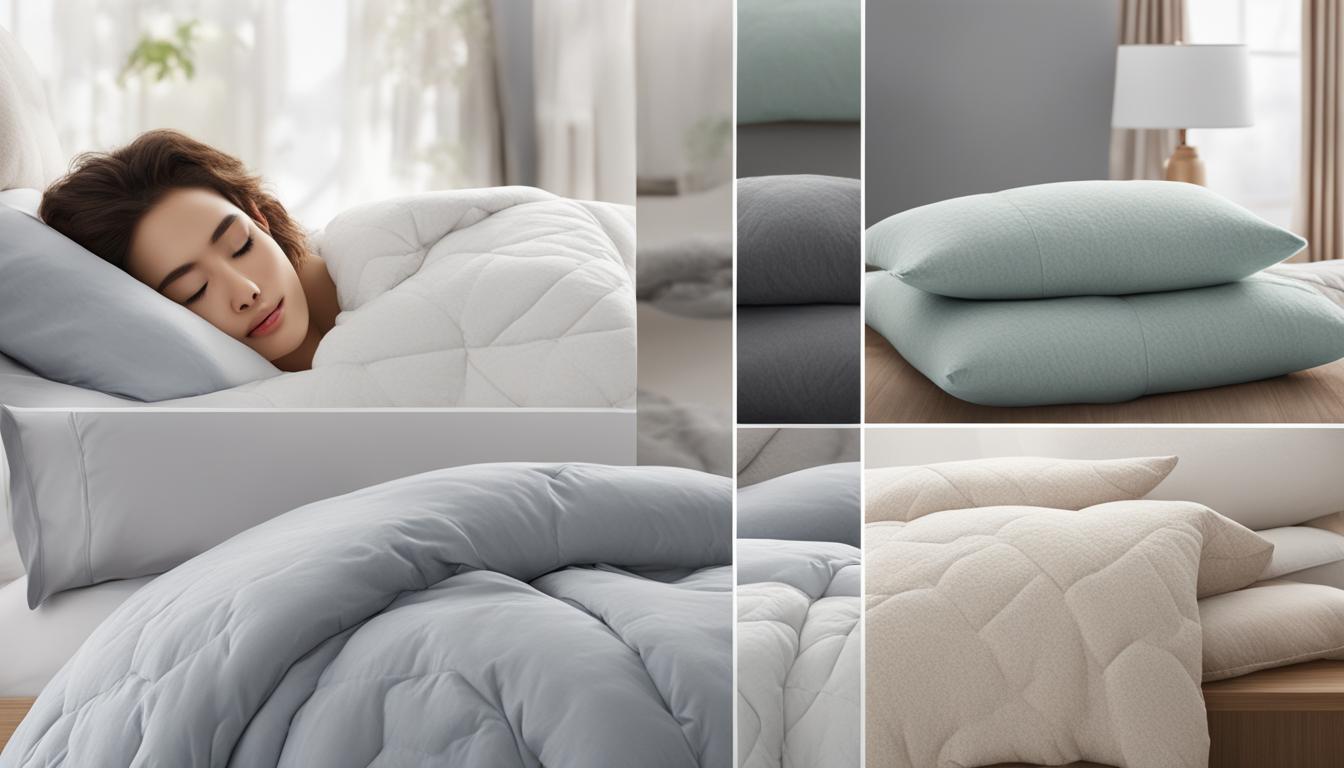Hypoallergenic Bedding for Children FAQs: Answering Your Key Questions!
If you have a child who suffers from allergies, you know how important it is to create a safe and comfortable sleep environment. Hypoallergenic bedding for children can make a big difference in reducing allergies and improving sleep quality. But what exactly is hypoallergenic bedding, and how does it work?
Hypoallergenic bedding refers to bedding materials that are designed to minimize allergen exposure, especially from dust mites. Dust mites are tiny arachnids that can cause allergies and asthma symptoms in sensitive individuals. They thrive in warm, humid environments like beds, and their waste particles can trigger allergic reactions. Hypoallergenic bedding creates a physical barrier between your child and dust mites, blocking them from infesting the bed and reducing the risk of allergies.
But choosing the right hypoallergenic bedding can be overwhelming, especially with so many options available. To help you navigate through the process, we’ve put together a list of frequently asked questions about hypoallergenic bedding for children.
Key Takeaways:
- Hypoallergenic bedding creates a physical barrier between your child and dust mites, reducing the risk of allergies.
- Dust mites are tiny arachnids that thrive in warm, humid environments like beds and produce allergenic waste particles.
- Allergy bedding is made from tightly woven fabrics with small pores that block dust mites and allergens.
- It is important to wash allergy bedding frequently and follow proper cleaning instructions.
- Hypoallergenic bedding is recommended for children who suffer from allergies, especially dust mite allergies.
What are Dust Mites and How Do They Cause Allergies?

Dust mites are microscopic arachnids that thrive in warm, humid environments like beds. These tiny creatures, too small to be seen with the naked eye, feed on dead skin cells and reproduce rapidly. Unfortunately, dust mites are not just harmless spectators in our lives – they produce allergenic waste particles that can trigger allergies and asthma symptoms in sensitive individuals.
The allergenic waste particles produced by dust mites can lead to various discomforting symptoms, such as sneezing, itchy/watery eyes, nasal congestion, a runny nose, respiratory problems, and even skin irritation. Individuals with dust mite allergies often experience these symptoms throughout the year, a condition known as year-round allergic rhinitis.
Dust mite allergies are particularly common because these arachnids quickly multiply and populate our beds, where we spend a significant portion of our time. The concentration of allergens they produce can intensify, exacerbating allergic responses in susceptible individuals.
Contrary to popular belief, it’s important to note that dust mites do not bite. If you see insects or experience skin bites, these are unlikely to be caused by dust mites. Dust mites are solely responsible for the allergenic waste particles that trigger allergic reactions.
Dust mites are microscopic arachnids that thrive in warm, humid environments. They produce allergenic waste particles that can cause allergies and asthma symptoms in sensitive individuals. If you suffer from sneezing, itchy eyes, nasal congestion, or other allergy symptoms, dust mite allergies may be the culprit. Understanding the characteristics and effects of dust mites is crucial in managing and alleviating these allergies.
How Does Allergy Bedding Help Alleviate Allergies?

Allergy bedding, also known as dust mite bedding, plays a crucial role in alleviating allergies by creating a strong defense against dust mites and other allergens. Unlike regular bedding fabrics that have larger pores, allergy bedding is made from tightly woven fabrics with smaller pores that act as a physical barrier, preventing dust mites and allergens from permeating your bed. By blocking these allergenic waste particles, allergy bedding helps reduce the exposure to allergens while you sleep, resulting in fewer allergy symptoms.
Allergies caused by dust mites can lead to sneezing, itchy/watery eyes, nasal congestion, runny nose, respiratory problems, and skin irritation. With allergy bedding, you can create a safe haven, sealing away existing dust mites and their allergens. This reduction in exposure to allergens can significantly alleviate allergy symptoms and improve your overall sleep quality.
Regular cleaning of allergy bedding is crucial to eliminate accumulated dust mites and other allergens. Washing your allergy bedding frequently removes the allergenic waste particles that can trigger allergies. Follow the manufacturer’s instructions for cleaning your specific allergy bedding to ensure it remains effective and in top condition.
Advantages of Allergy Bedding:
- Blocks dust mites and allergens
- Reduces exposure to allergenic waste particles
- Alleviates allergy symptoms, such as sneezing and nasal congestion
- Improves sleep quality
- Creates a safe sleep environment
Types of Allergy Bedding:
| Allergy Bedding Type | Description |
|---|---|
| Microfiber Polyester | Soft, cool, and long-lasting |
| Cotton | Breathable and lightweight; may absorb moisture |
| Organic Cotton | Made from certified organic cotton fabric; provides the same protection as regular cotton |
Incorporating allergy bedding into your sleep routine can make a significant difference for individuals suffering from allergies, especially those triggered by dust mites. By choosing the right type of allergy bedding and maintaining it properly, you can create a cleaner and healthier sleep environment, free from allergenic waste particles. Say goodbye to nighttime discomfort and wake up refreshed with allergy bedding.
Choosing the Right Allergy Bedding for Children

When it comes to selecting the perfect allergy bedding for your children, it’s essential to take into account their specific needs and sensitivities. With a wide variety of options available, understanding the different fabric types and their hypoallergenic properties can help you make an informed decision.
Look for bedding that is specifically labeled as hypoallergenic or dust mite bedding, ensuring it provides the necessary protection for your child. Allergy bedding is available in various fabric types, including microfiber polyester, cotton, and organic cotton, each with its own advantages and considerations.
Microfiber polyester: This fabric is known for its softness, durability, and coolness. It offers excellent hypoallergenic properties, making it a popular choice for allergy bedding. Its tightly woven structure prevents dust mites and allergens from penetrating the fabric and reaching your child’s skin.
Cotton: Cotton is a breathable and lightweight fabric that is commonly used in bedding. It allows for air circulation, keeping your child cool and comfortable throughout the night. However, cotton may have a tendency to absorb moisture, which can impact its hypoallergenic capabilities.
Organic cotton: If you prefer an eco-friendly option, organic cotton is an excellent choice. It offers the same level of protection as regular cotton, but it’s made from certified organic cotton fabric. By choosing organic cotton allergy bedding, you provide your child with a safer and more sustainable sleep environment.
| Fabric Type | Hypoallergenic Properties | Comfort Level |
|---|---|---|
| Microfiber polyester | Excellent | Soft and cool |
| Cotton | Good | Breathable but may absorb moisture |
| Organic cotton | Good | Same as regular cotton but made from certified organic fabric |
When choosing the fabric type for your child’s allergy bedding, consider their comfort and personal preferences. Each fabric option offers unique benefits, so selecting the one that aligns with your child’s specific needs can enhance their sleep experience and minimize allergies.
Tips for Maintaining and Cleaning Allergy Bedding

Proper maintenance and cleaning of allergy bedding are essential to ensure that it remains free of dust mites and allergens. By following the manufacturer’s washing instructions, you can effectively clean your allergy bedding and prolong its lifespan. Different fabric types may have specific care requirements, so it’s crucial to refer to the instructions provided.
Here are some general tips for cleaning your allergy bedding:
- Wash your allergy bedding at least once a week to reduce the build-up of dust and allergens. This frequency helps ensure that your bedding remains clean and free from potential allergens.
- Use hot water to eliminate dust mites and allergens effectively. Hot water not only removes dirt and stains but also helps kill dust mites and neutralize allergenic particles.
- Consider using mattress protectors and comforter covers that are easy to remove and wash. These protective barriers help prevent the accumulation of allergens on your bedding and make clean-up a breeze.
- Regularly vacuum and dust your bedroom to minimize the presence of dust and allergens in your sleeping environment. Use a vacuum cleaner with a high-efficiency particulate air (HEPA) filter to effectively capture dust and allergenic particles.
- Avoid using traditional dusters that can send dust particles into the air. Instead, use a damp cloth or microfiber dusting tool to trap dust and prevent it from resettling.
Expert Tip:
When washing your allergy bedding, make sure to select a detergent that is fragrance-free and hypoallergenic. Fragrances in detergents can potentially trigger allergic reactions in sensitive individuals. Opting for a gentle, hypoallergenic detergent helps ensure that your bedding remains free from harsh chemicals.
By regularly following these cleaning tips and maintaining your allergy bedding, you can create a healthier sleeping environment and reduce your exposure to allergens.
| Cleaning Tip | Description |
|---|---|
| Wash at least once a week | Reduce dust and allergen build-up |
| Use hot water | Effectively eliminate dust mites and allergens |
| Use mattress protectors and comforter covers | Prevent allergen accumulation and facilitate easy cleaning |
| Regularly vacuum and dust | Minimize dust and allergen presence in the bedroom |
| Avoid traditional dusters | Use damp cloth or microfiber tools to trap dust |
Other Allergy-Proofing Tips for the Home
In addition to using allergy bedding, there are other steps you can take to allergy-proof your home. By implementing these tips, you can reduce allergens and create a cleaner and healthier environment for you and your family.
Dusting and Vacuuming
Regularly dusting and vacuuming your home is essential to remove dust and allergens from surfaces and carpets. Dust all surfaces using a damp rag or mop, as traditional dusters can send dust particles into the air. Vacuum carpets and upholstery at least once a week to eliminate dust mites, pet dander, and other allergens. Ensure that you use a vacuum cleaner with a HEPA filter to trap even the smallest particles.
Humidity Control
Keeping humidity levels in your home under control is crucial for reducing allergens. High humidity can promote the growth of dust mites and mold, which can trigger allergies and asthma symptoms. Consider using dehumidifiers in areas prone to high humidity, such as basements and bathrooms. Aim to maintain humidity levels between 30% and 50% to create an inhospitable environment for allergens.
Remove Clutter and Non-Washable Items
Cluttered spaces provide hiding spots for dust, making it harder to keep your home allergen-free. Remove unnecessary clutter and non-washable items that can collect dust, such as curtains and blinds. Opt for washable window treatments that can be easily cleaned to prevent dust build-up.
Proper Care and Maintenance
Pay attention to the care and maintenance of your home to prevent the accumulation of allergens. Regularly clean bedding, curtains, and other washable items to remove dust mites and allergens. Use mattress protectors and allergen-proof covers to safeguard your mattress and pillows from dust mites. Replace air filters in your HVAC system regularly to ensure clean air circulation.
To summarize, incorporating these allergy-proofing tips will help you reduce allergens in your home and create a cleaner, healthier environment. By dusting, vacuuming, controlling humidity, removing clutter, and practicing proper care and maintenance, you can minimize allergy triggers and enjoy a more comfortable living space.
Conclusion
Hypoallergenic bedding, also known as dust mite bedding, is a game-changer for individuals who suffer from allergies, especially dust mite allergies. By creating a physical barrier between you and dust mites, hypoallergenic bedding prevents these pesky allergens from infesting your bed and causing allergic reactions.
Allergy bedding is crafted from tightly woven fabrics with smaller pores, preventing dust mites and other allergens from penetrating the material. Although hypoallergenic bedding does not cure allergies, it can significantly reduce reactions and improve the quality of your sleep environment.
It is crucial to wash your allergy bedding regularly following proper cleaning instructions. By doing so, you remove dust mites and allergens, ensuring a cleaner sleep environment. Combine this with other allergy-proofing tips for your home, such as regular dusting and vacuuming, maintaining humidity levels, and removing clutter, to further reduce allergen exposure and create a healthier space.
For a more comfortable and restful sleep experience free from the grip of allergies, consider investing in hypoallergenic bedding. By prioritizing cleanliness and maintaining good sleep hygiene, you can create a sleep haven that promotes better sleep and helps alleviate dust mite allergies.
FAQ
What are dust mites and how do they cause allergies?
Dust mites are microscopic arachnids that thrive in warm, humid environments like beds. They produce allergenic waste particles that can cause allergies and asthma symptoms in sensitive individuals.
How does allergy bedding help alleviate allergies?
Allergy bedding, also known as dust mite bedding, creates a physical barrier between you and dust mites, preventing them from infesting your bed and causing allergic reactions. It reduces exposure to allergens while you sleep, resulting in fewer allergy symptoms.
How do I choose the right allergy bedding for children?
When choosing allergy bedding for children, look for bedding that is specifically labeled as hypoallergenic or dust mite bedding. Consider their comfort and personal preferences for fabric types such as microfiber polyester, cotton, or organic cotton.
What are the tips for maintaining and cleaning allergy bedding?
Proper maintenance and cleaning of allergy bedding are necessary to keep it free of dust mites and allergens. Follow the manufacturer’s washing instructions and wash allergy bedding at least once a week using a hot water cycle. Consider using mattress protectors and comforter covers that are easy to remove and wash.
What are other allergy-proofing tips for the home?
In addition to using allergy bedding, regularly dust and vacuum your home to remove dust and allergens. Use a damp rag or mop to clean dust, control humidity levels, and remove clutter and non-washable items that can collect dust.
Should I replace my regular bedding with hypoallergenic bedding?
Hypoallergenic bedding, also known as dust mite bedding, can help alleviate allergies caused by dust mites and other allergens. It does not cure allergies, but it can reduce reactions and improve sleep quality.




